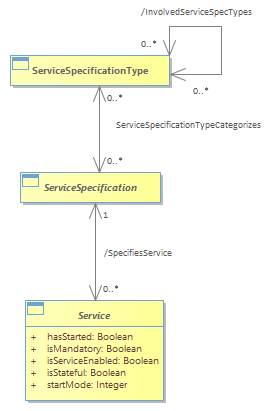Figure SO.14 - The Concept of a ServiceSpecificationType

|
Project:
|

Figure SO.14 - The Concept of a ServiceSpecificationType : Class diagram
The preceding discussion has shown that multiple ServiceSpecifications can share common characteristics. This can be more efficiently represented using the concept of a ServiceSpecificationType.<br/>The ServiceSpecificationType defines a generic category of ServiceSpecifications. Each ServiceSpecificationType serves to group a set of particular ServiceSpecifications that can be used together. The result of this is a more efficient ability to define a set of related Services that can be grouped together to form a higher-level Service. For example, a given higher-level Service might include VPN and QoS Services. If these Services are always used together, then they can be categorized using a common type.<br/>The ServiceSpecificationTypeCategorizes association defines how ServiceSpecificationTypes categorize different ServiceSpecifications. The InvolvedServiceSpecTypes is a derived association as indicated by the “/” prefix. It is derived from an association between EntitySpecificationTypes which enables hierarchies of specification type entities to be defined.<br/>Note that in principle, ServiceSpecificationType could be subclassed, so that the subclasses of ServiceSpecificationType could be used to categorize different subclasses of ServiceSpecification. This is not recommended for the purposes of this document, as the ServiceSpecificationType object is used solely to help categorize objects. The only reason a ServiceSpecificationType object should be subclassed is if that subclass adds additional semantics (in the form of attributes, relationships, and/or constraints). Thus, it makes perfect sense for applications that are based on the SID to subclass ServiceSpecificationType.<br/>
|




